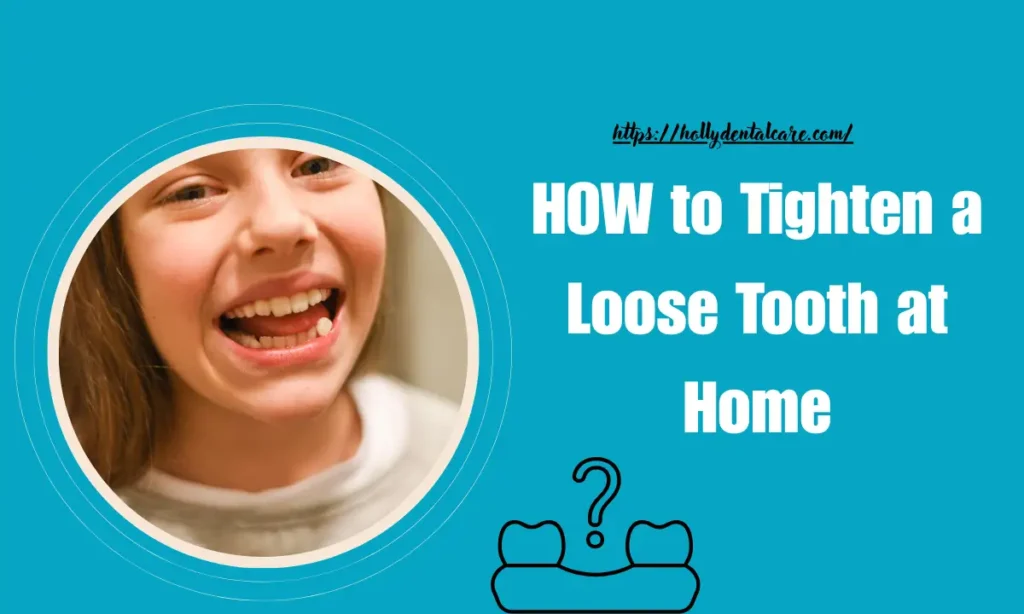Childhood is about innocent celebrations of teeth that wiggle away, for it’s a sign that the child has grown. However, any form of tooth mobility strikes fear in the heart of every adult. What if the tooth was lost by some dental complication? Treatment at an appropriate time can save the day anyway. There are home treatments that are safe and natural and may assist in tightening a loose tooth. This article will explain the How to Tighten a Loose Tooth at Home causes and symptoms of a loose tooth, the natural and safe remedies available at home, and finally, the instances when you should seek professional dental help.
Understanding Loose Tooth
Periodontal Disease (Gum Disease)
Gum disease tears down the bones and tissues that hold the teeth in place in the phase of a quite advanced disease. Whenever plaque accumulates under the gumline, the result is infection, followed by irritation and eventually tooth looseness.
Trauma or Injury
Physical trauma (e.g., sports injury, accident, teeth grinding) may damage the ligaments that hold the tooth.
Osteoporosis
Declining bone density may be a factor in the decreased baboon jawbone integrity whereby this degeneration often leads to the loosening of teeth.
Hormones of Pregnancy
Pregnancy hormones may also lead to a little mobility in the teeth of these women because of the effect of the hormones on the periodontal ligaments.
Poor Oral Hygiene
Tartar and plaque irritating the gums can cause inflammatory activity leading to recession and progression till the tooth becomes loose.
Can a Loose Tooth Tighten on Its Own?
In mild tooth loosening, which frequently occurs mainly due to inflammation and not mostly due to structural destruction, treatment initiated early enough can allow the tooth to reestablish itself in the gum and bone.
Symptoms of a Loose Tooth
- A tooth moves upon touch or lightly twists.
- Swollen gums or redness, easy bleeding upon touch.
- Receding gums.
- Particularly sensitive tooth or dentition.
- Painful chewing.
Home Remedies to Tighten a Loose Tooth
Rinse With Saltwater
Loose teeth can benefit from the saltwater rinse through its collagen-stabilizing antibacterial activities and through its anti-inflammatory properties in hastening the healing of the gum by reducing inflammation and preventing bacteria. To use, dissolve in a glass of warm water ½ teaspoon of sea salt and swish in the mouth for approximately 30 seconds; then spit it out. Repeat the treatment 2-3 times daily.
Using Oil Pulling (Either Coconut or Sesame Oil)
Oil pulling claims to pull out toxins, decrease the number of dangerous bacteria, and assist in smoothly healthy gums. Take one tablespoon of coconut or sesame oil and swish it around in the mouth carefully for 15 to 20 minutes, then spit it out and wash with warm water (not swallowing any). Use this once a day, preferably in the morning, before the teeth are brushed.
Turmeric Paste
Turmeric is widely verified in research works that curcumin has anti-inflammatory and antimicrobial properties, and it can bring down the swelling in the gum tissue and tighten it up. Herein, add half a teaspoon of turmeric powder with a few drops of water or coconut oil. Then, apply it to the gums that are affected directly. Allow to dry for about 10-15 minutes, then rinse. The recommended application is once per day.
Aloe Vera Gel
Soothing, anti-bacterial, and healing properties of aloe vera bring down gum inflammation and promote tissue repair. Take the fresh green aloe vera gel and apply it directly onto the gums; massage for a few minutes and leave it for the same duration. Rinse after 15-20 minutes. Twice a day is very beneficial.
Garlic Clove or Paste
Garlic is strong in medicinal terms, and it acts well against bacteria or infections of any type that cause loosening of teeth. Take one clove of garlic, crush it to prepare a paste, and apply it to that area. After it is set up for five to ten minutes, rinse off with lukewarm water.
Hydrogen Peroxide Rinse
Hydrogen peroxide severely handles the inflammation process as well as kills any bugs present below the gum line. Thus, it also contributes to gum healing. Use well-mixed 3 percent hydrogen peroxide mixed in water in a 1:1 ratio; swish around the mouth for 30 seconds and spit it out. Once every day, but not more than two to three times a week. Don’t swallow; moreover, excess use can irritate the gums.
Clove Oil
Cloves oil, natural for their analgesic and antiseptic properties, help in easing pain, preventing infection, and acting on the gums with impetus for healing. A little quantity is taken with a cotton swab, rubbed on the affected tooth, including its surrounding gums. An application should be done once or twice each day.
Diet Tips to Strengthen Teeth and Gums
Recommended Foods
- Calcium foods: milk, cheese, yogurt, almond nuts, and deep green leafy vegetables.
- Vitamin-rich foods- oranges, guava, bell peppers, and kiwi.
- Sources of vitamin D: sun, egg yolk, and fortified milk( enables to absorption of calcium).
- Magnesium- nuts, whole cereals, pumpkin seeds, and certain types of fish, and phosphorus.
- Collagen protein sources include bone broth, fish, and eggs.
Avoid
- Sticky or dense foods
- Gum disease is aggravated due to an excess of sugary and soft drinks.
- Sugar and soft drinks are sociable beverages.
- Alcohol and tobacco also aggravate the gums.
How to Prevent it from Worsening
- Do not brush hard because that would just promote further gum recession.
- Use an oral rinse with natural ingredients or mouthwash endorsed by your dentist to fight bacteria.
- Drinking water naturally maintains the oral pH and also washes away bacteria.
Stabilizing the Loose Tooth Temporarily at Home
- Do not chew on the side where it hurts.
- Only use a dental splint kit under guidance from a dental professional experienced in TMJ disorders (these are available for purchase online).
- Elevate the head with more pillows during sleep so which can help decrease swelling.
- Avoid grinding or clenching; if you must, a night guard is sug
When to Seek Professional Dental Care
You should consult a dentist if
- The tooth becomes more and more congenitally loose.
- The presence of pus, swelling, or everlasting bleeding.
- The tooth hurts unbearably, and discoloration is seen.
- Injury and bruxism are other matters considered here.
- Home care hasn’t brought any improvement in 1-2 weeks.
Professional Dental Treatments for Loose Teeth
- This includes deep cleaning (Scaling & Root Planing) to get rid of plaque/tartar.
- It involves splinting a loose tooth to the adjacent tooth or teeth.
- It involves either bone grafting or gum grafting to replace lost support.
- This involves surgical flap procedures to clean deep pockets around the gums.
- Tooth extraction and replacement of the tooth if it is not possible to save it.
Conclusion
Your dentist may tell you that a little looseness of that tooth can be treated, and it does not mean the tooth has been lost. Early treatment and proper oral hygiene at home are very essential; a few natural remedies rinsing with warm salt water and oil pulling with turmeric or garlic, may help with slight loosening. However, home treatment plus dental visits to identify and treat any small problem quickly may really help a lot of people! With the right attitude, nutrition, and consistent care, one could maintain teeth in good shape for a lifetime.
Also read:- Tooth Pain Tablet Name: Top Choices to Ease Your Dental Pain Fast



